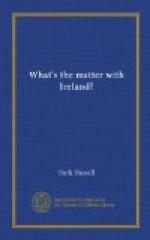New building grants were suspended altogether for a time. In 1902, an annual grant of L185,000 was diverted from Irish primary education and used for quite extraneous purposes. And when England does give money for Irish education, she pays no heed to the requirements stated by the Irish commissioners of education.[23] Instead she says: “This amount I happen to be giving to English education; I will grant a proportionate amount to Irish education.”
“If English primary education happens to require financial aid from the Treasury, Irish primary education is to get some and in proportion thereto,” writes the committee. “If England happens not to require any, then, of course, neither does Ireland. A starving man is to be fed only if some one else is hungry.... It seems to us extraordinary that Irish primary education should be financed on lines that have little relation to the needs of the case."[24]
So there are not enough schools to go to. Belfast teachers testified before the committee that in their city alone there were 15,000 children without school accommodations. Some of the number are on the streets. Others are packed into educational holes of Calcutta. New schools, said the teachers, are needed not only for these pupils but also for those incarcerated in unsuitable schools—unheated schools or schools in whose dark rooms gas must burn daily. On the point of unsuitability, the testimony of a special investigator named F.H. Dale was quoted. He said:
“I have no hesitation in reporting that both in point of convenience for teachers and in the requirements necessary for the health of teachers and scholars, the average school buildings in Dublin and Belfast are markedly inferior to the average school buildings now in use in English cities of corresponding size.”
So if unsuitable schools were removed, Belfast would have to provide for some thousands of school children beyond the estimate of 15,000, and other localities according to their similar great need.[25]
Live, interesting primary teachers are few in Ireland. The low pay does not begin to compensate Irish school teachers for the great sacrifices they must make. Women teachers in Ireland begin at $405 a year; men at $500. If it were not for the fact that there are very few openings for educated young men and women in a grazing country there would probably be even greater scarcity.[26] Since three-fourths of the schools are rural those who determine to teach must resign themselves to social and professional hermitage. What is the result of these factors on the teaching morale? The 1918 report at the education office shows 13,258 teachers, and only 3,820 of these are marked highly efficient.[27]
Thus the committee of the lord lieutenant.
[Footnote 1: “Ireland’s Crusade Against Tuberculosis.” Edited by Countess of Aberdeen. Maunsel and Company. Dublin. 1908. P. 32.]
[Footnote 2: “Marriages, Births, and Deaths in Ireland, 1917.” His Majesty’s Stationery Office. Dublin. 1918. P. IX.]




